Features
- Focal lengths up to 24 mm
- Plano-convex lenses made of fused silica
- AR coated
- Choice of fiber receptacles: FC PC or FC APC (standard)
- Focussing of the optics using eccentric key
- Compact Ø 12 mm housing
- Nickel silver
Special series with bore hole for purging
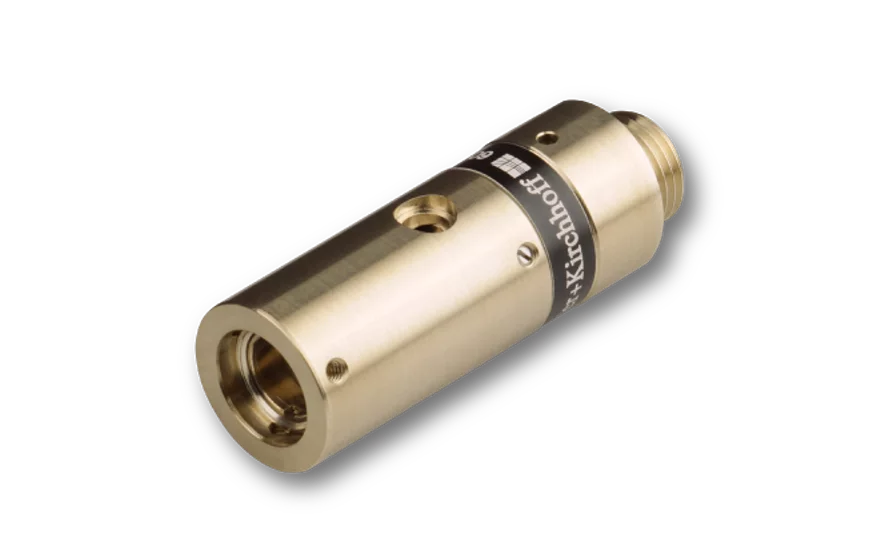
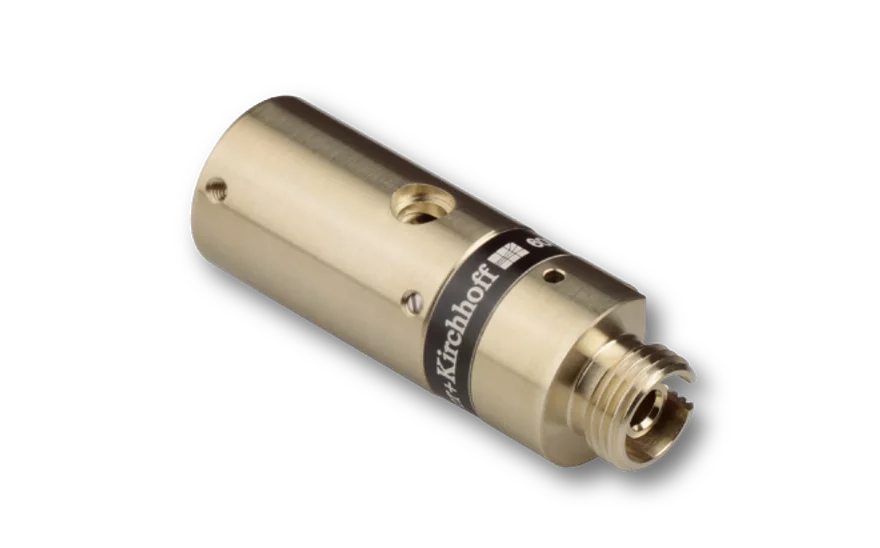
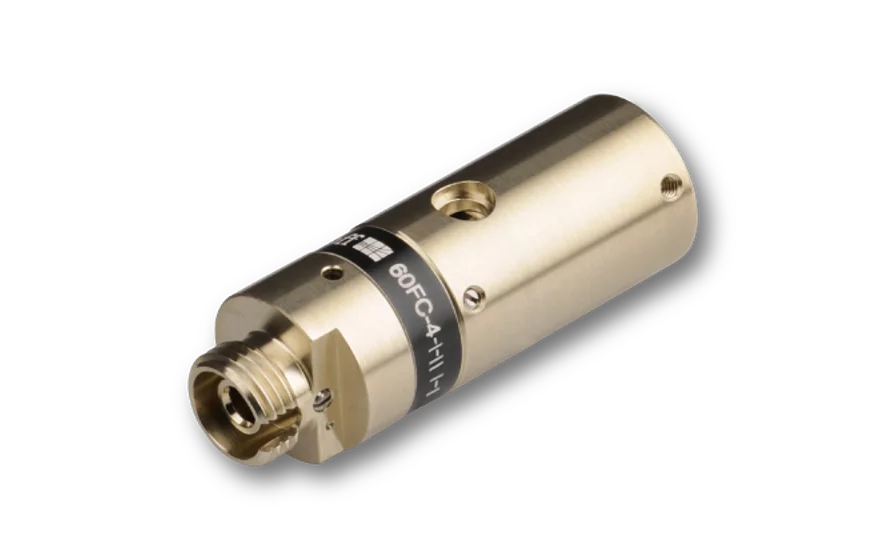
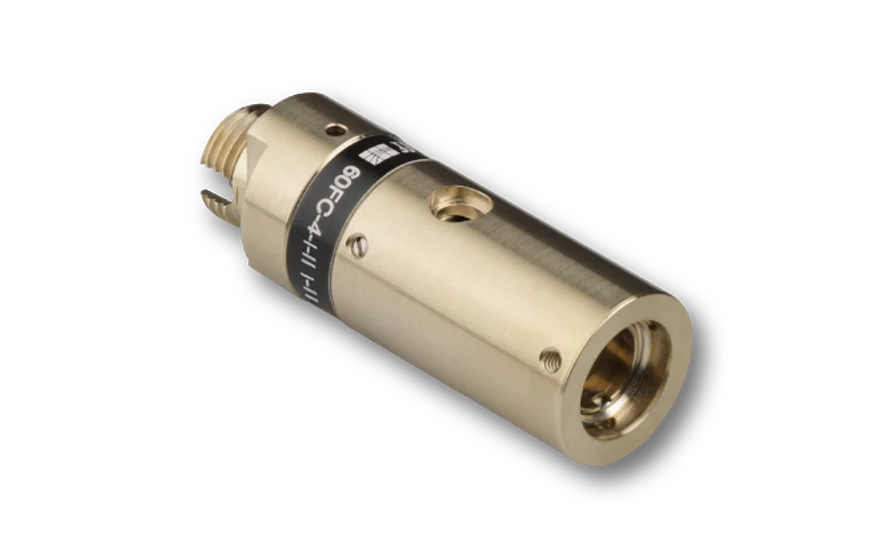
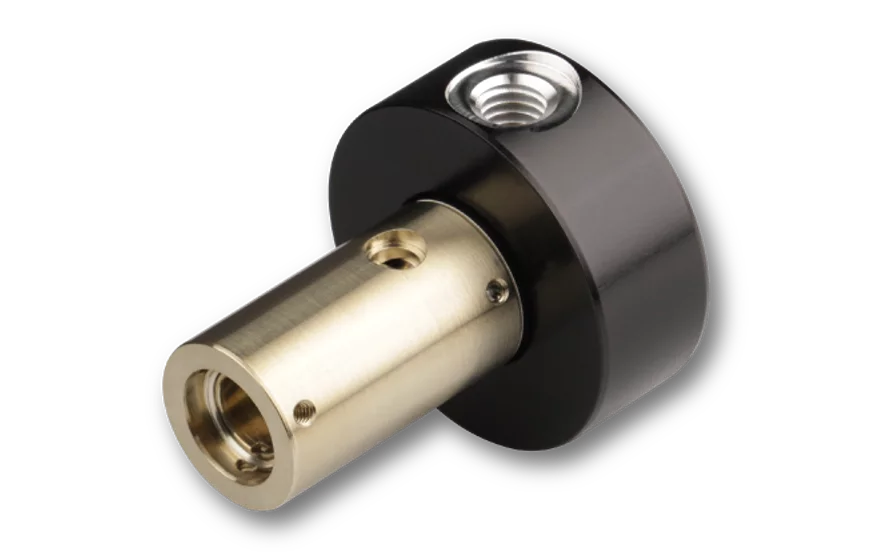
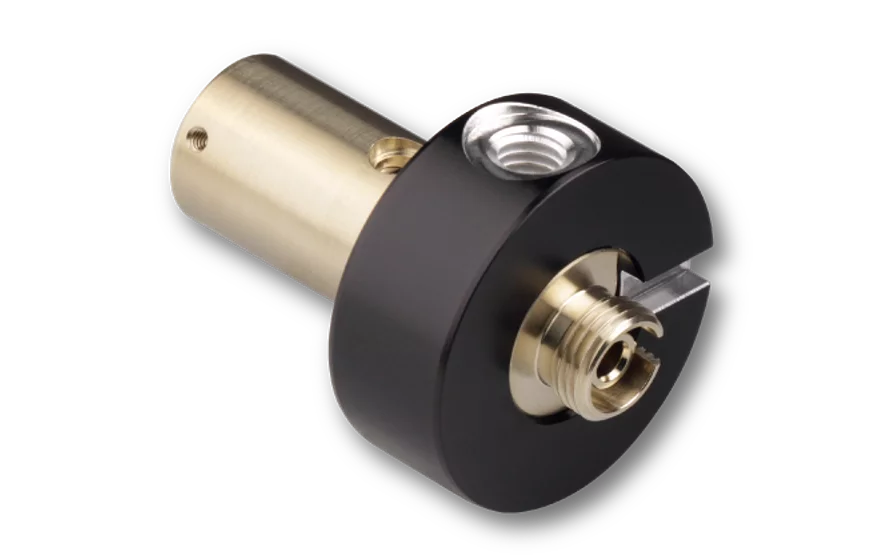
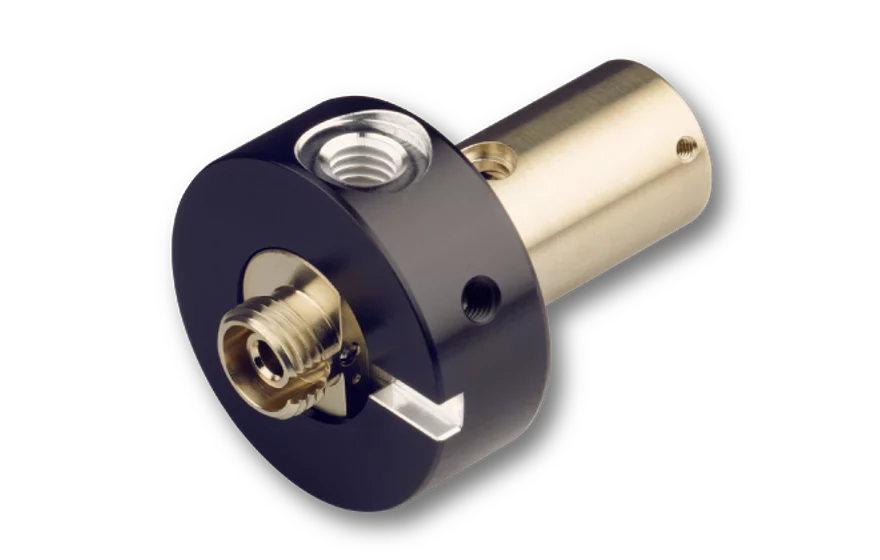
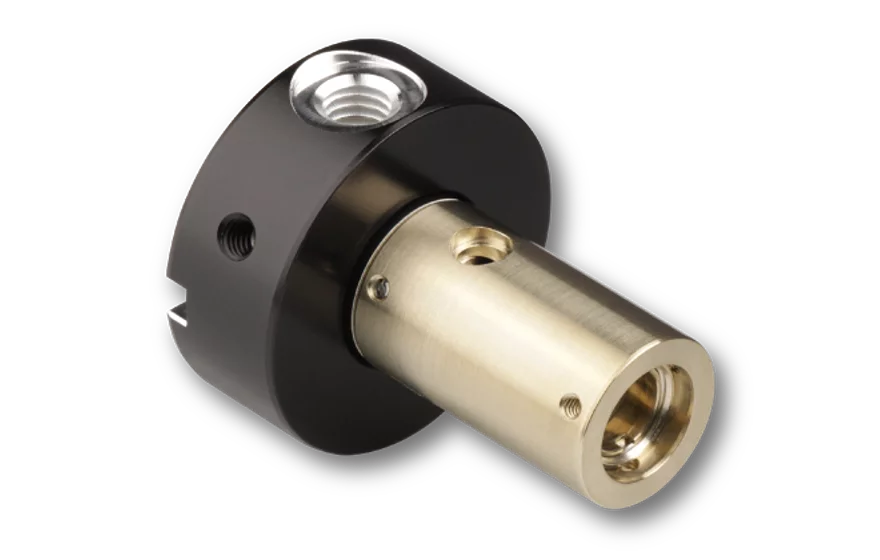
These fiber collimators are a specially modified version of the series 60FC fiber collimators. They additionally have a radially arranged bore hole with M3 thread for purging (flushing) purposes.
The possibility of purging these fiber collimators makes them suitable for UV applications. (Reference: Marciniak et al., arXiv:1704.05879)
Optics for the UV
Unlike the standard series 60FC fiber collimators this series is offered with fused silica lenses which are suitable for wavelengths starting from 250 nm. Since these are plano convex lenses, they are diffraction-limited for fibers with an NAe2 < 0.04 only. All lenses are AR-coated.
Adjustment of focus
Such as with the standard series 60FC fiber collimators, the distance between fiber end-face and collimating optics is adjusted by means of an eccentric key. The lens does not rotate when adjusting the focus. The final focus setting is locked by means of two radially arranged clamping screws.
Optimum lens performance
The angled polish of connectors of type APC is considered by a pre-angled mechanical coupling axis that compensates the beam deflection and you can use the lens centrically. This minimizes aberrations simply resulting from a non-ideal beam path through the lens.
Connector Type
The fiber collimator can be equipped with FC PC or FC APC receptacles. the fiber receptacle has an additional grub screw to increase pointing stability.
Material
The fiber collimators are available in nickel silver.
Mounting
The fiber collimators are mounted using special adapter rings with e.g system mount Ø 19.5 mm or with outer diameter Ø 25 mm (e.g. for use with standard kinematic mirror mounts) that have a bore hole that matches the bore hole of the fiber collimator. A thread allows for connecting a flush nozzle.

| Order Code | Focal length | Lens Type | AR Coating | Connector type* | Tilt | Outer |
|---|---|---|---|---|---|---|
| 60FC-4-S6-49-XV | 6 mm | bi-convex | 250 - 420 nm | FC-APC | Ø 12 mm | |
| 60FC-4-S9-49-XV | 9 mm | plano-convex | 250 - 420 nm | FC-APC | Ø 12 mm | |
| 60FC-4-S12-49-XV | 12 mm | plano-convex | 250 - 420 nm | FC-APC | Ø 12 mm | |
| 60FC-4-S15-49-XV | 15 mm | plano-convex | 250 - 420 nm | FC-APC | Ø 12 mm | |
| 60FC-4-S18-49-XV | 18 mm | plano-convex | 250 - 420 nm | FC-APC | Ø 12 mm | |
| 60FC-4-S20-49-XV | 20 mm | plano-convex | 250 - 420 nm | FC-APC | Ø 12 mm | |
| 60FC-4-S24-49-XV | 24 mm | plano-convex | 250 - 420 nm | FC-APC | Ø 12 mm | |
| * Other connector types on request | ||||||
Differences between aspheres, achromats and apochromats
Reasons for a pre-angled coupling axis
Why you should tighten the grub screw for the fiber ferrule.
Selection of focal length, estimated coupling efficiency
Selection of focal length, estimated coupling efficiency
Selection of focal length and effective coupling diameter
Sources of loss when fiber-coupling
Coupling of plasma, LED and fluorescent light
Industry-grade fiber coupling for different well-esablished laser systems
How measured fiber parameters help to choose the best coupling and collimation optics.
Making single-mode fiber coupling smooth and permanent
Collimated beam diameter, beam divergence, pilot beam
Selection of focal length or determination of the resulting beam diameter
Practical collimation tips for single-mode, polarization-maintaining and multimode fibers
Beam divergence of a collimated beam exiting a single-mode fiber
Approximate constant beam diameter across a certain working range
How measured fiber parameters help to choose the best coupling and collimation optics.
Cooling and trapping atoms using specially developed fiber collimators
This downloads section only includes general downloads for the complete series.
Please access the individual product pages (using the product configurator, the product list, order options or the search button if you have a complete order code). Here you will find specific downloads including technical drawings or stepfiles.
for collimating radiation exiting an optical fiber or as an incoupler
| Lens Code | A2 | A2.7 | A3.1 | M3.1 | A4 | M4 | A4.5 | A4.5S | M5 | A6.2 | A6.2S | M6.2 | A7.5 | M7.5 | A8 | M8 | A9.6 | M10 | A11 | M11 | RGBV11 | M12 | M12NIR | M15 | A15 | A15 | A18 | M18 | M20 | A22 |
| Focal length f' | 2.0 | 2.7 | 3.1 | 3.1 | 4.0 | 4.0 | 4.5 | 4.5 | 5.0 | 6.2 | 6.2 | 6.2 | 7.5 | 7.5 | 8.0 | 8.0 | 9.6 | 10.0 | 11.0 | 11.0 | 11.0 | 12.0 | 12.0 | 15.0 | 15.3 | 15.4 | 18.4 | 18.4 | 20.0 | 22.0 |
| Numerical Apperture NA | 0.5 | 0.65 | 0.68 | 0.27 | 0.64 | 0.21 | 0.5 | 0.43 | 0.25 | 0.4 | 0.3 | 0.2 | 0.3 | 0.29 | 0.31 | 0.23 | 0.3 | 0.21 | 0.25 | 0.23 | 0.18 | 0.23 | 0.23 | 0.19 | 0.16 | 0.16 | 0.15 | 0.18 | 0.17 | 0.13 |
| Clear apert. max. [mm] | 2.4 | 3.6 | 5 | 1.7 | 5.1 | 1.7 | 4.95 | 3.7 | 2.8 | 4.95 | 3.7 | 2.5 | 4.5 | 4.5 | 4.93 | 3.8 | 5.2 | 4.2 | 5.5 | 5.2 | 4 | 5.4 | 5.4 | 5.6 | 5 | 5 | 5.5 | 6.6 | 6.8 | 5.7 |
| Correction - achrom. | X | X | X | X | X | X | X | X | X | X | ||||||||||||||||||||
| 250 - 700 nm | 48 | |||||||||||||||||||||||||||||
| 350 - 700 nm | 01 | 01 | 01 | 01 | 01 | 01 | 01 | 01 | 01 | 01 | 01 | 01 | ||||||||||||||||||
| 390 - 670 nm | 33 | 33 | 33 | 33 | 33 | 33 | ||||||||||||||||||||||||
| 400 - 1000 nm | 24 | 24 | ||||||||||||||||||||||||||||
| 400 - 700 nm | 01 | 01 | 47 | 01 | ||||||||||||||||||||||||||
| 420 - 700 nm | 26 | 26 | ||||||||||||||||||||||||||||
| 450 - 700 nm | 04 | |||||||||||||||||||||||||||||
| 520 - 830 nm | 18 | |||||||||||||||||||||||||||||
| 600 - 1100 nm | 02 | 02 | 02 | 02 | 02 | 02 | 02 | 02 | 02 | 02 | 02 | 02 | ||||||||||||||||||
| 630 - 1080 nm | 10 | 10 | 10 | 10 | 10 | 10 | ||||||||||||||||||||||||
| 630 - 980 nm | 10 | 10 | ||||||||||||||||||||||||||||
| 650 - 1050 nm | 02 | 02 | ||||||||||||||||||||||||||||
| 650 - 1150 nm | 07 | 07 | 07 | |||||||||||||||||||||||||||
| 750 - 1550 nm | 37 | 37 | 37 | |||||||||||||||||||||||||||
| 980 - 1550 nm | 08 | 08 | 08 | 08 | 08 | 08 | 08 | |||||||||||||||||||||||
| 1050 - 1650 nm | 03 | 03 | 03 | 03 | 03 | 03 | 03 | 03 | 03 | 03 | 03 | 03 | ||||||||||||||||||
| 1050 - 1700 nm | 03 | |||||||||||||||||||||||||||||
| 1300 - 1700 nm | 45 | 45 | 45 | 45 | 45 | 45 | 45 | 45 | ||||||||||||||||||||||
| 1500 - 1780 nm | 22 | |||||||||||||||||||||||||||||
| 1750 - 2300 nm | 09 | |||||||||||||||||||||||||||||
| 1750 - 3000 nm | 64 | |||||||||||||||||||||||||||||
| 2500 - 6000 nm | 63 | |||||||||||||||||||||||||||||
| Lens Code | A2 | A2.7 | A3.1 | M3.1 | A4 | M4 | A4.5 | A4.5S | M5 | A6.2 | A6.2S | M6.2 | A7.5 | M7.5 | A8 | M8 | A9.6 | M10 | A11 | M11 | RGBV11 | M12 | M12NIR | M15 | A15 | A15 | A18 | M18 | M20 | A22 |
| Focal length f' | 2.0 | 2.7 | 3.1 | 3.1 | 4.0 | 4.0 | 4.5 | 4.5 | 5.0 | 6.2 | 6.2 | 6.2 | 7.5 | 7.5 | 8.0 | 8.0 | 9.6 | 10.0 | 11.0 | 11.0 | 11.0 | 12.0 | 12.0 | 15.0 | 15.3 | 15.4 | 18.4 | 18.4 | 20.0 | 22.0 |
| Numerical Apperture NA | 0.5 | 0.65 | 0.68 | 0.27 | 0.64 | 0.21 | 0.5 | 0.43 | 0.25 | 0.4 | 0.3 | 0.2 | 0.3 | 0.29 | 0.31 | 0.23 | 0.3 | 0.21 | 0.25 | 0.23 | 0.18 | 0.23 | 0.23 | 0.19 | 0.16 | 0.16 | 0.15 | 0.18 | 0.17 | 0.13 |
| Clear apert. max. [mm] | 2.4 | 3.6 | 5 | 1.7 | 5.1 | 1.7 | 4.95 | 3.7 | 2.8 | 4.95 | 3.7 | 2.5 | 4.5 | 4.5 | 4.93 | 3.8 | 5.2 | 4.2 | 5.5 | 5.2 | 4 | 5.4 | 5.4 | 5.6 | 5 | 5 | 5.5 | 6.6 | 6.8 | 5.7 |
| Correction - achrom. | X | X | X | X | X | X | X | X | X | X |